Off The Beaten Track In Prachuap Khiri Khan: Further Adventures With Cave Man Jim – Part Two
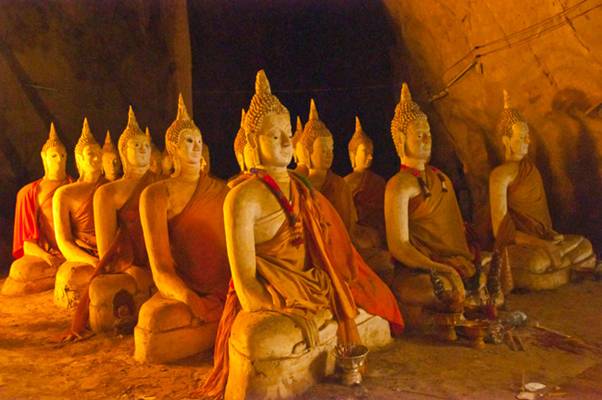
The following morning dawned bright and clear and Jim was at the hotel’s lobby, at 10 AM, to pick me up in a car we’d rented for the day’s outing. The run down to Prachuap Khiri Khan was fairly straight forward; we’d
be on the motorway for an hour, or so, before turning off towards the coast. The first location, we planned to visit, was a temple on top of a promontory overlooking the ocean. As we motored down the highway, Jim gave me some background info
on what to expect.
“The temple is in a bit of a remote place and hard to find. Not many tourists get there which is a shame because there’s some neat stuff to see. The temple’s at the bottom of the hill and there’s a long flight
of stairs up to a cave at the top. The cave’s not as big as some of the others we’ve been to, in Hua Hin, but it’s got a whole bunch of Buddha statues inside. The main attraction is the crystal Buddha.”
“What’s that?” I said, becoming more intrigued.
Well, as far as I know, it’s the only place with a Buddha statue made of glass. They’ve got it right up in the back end of the cave positioned beneath a small hole in the cave ceiling. When the sun is in the right position,
a beam of light shines down through the hole and lights up the crystal Buddha. The trick is getting there at the right time.”
“Any idea what the right time might be?”
“Probably around midday, when the sun is directly overhead.”
The town of Prachuap Khiri Khan is the provincial capital of Prachuap Khiri Khan Province, which also includes the city of Hua Hin, and hugs the coastline a few kilometers off the main highway. It’s a picturesque city with a number
of high peaks, and promontories, punctuating the landscape throughout, and beyond, its boundaries. I’d driven by, a few times, and had always been impressed by the geography along the coastline of this part of Thailand. This was the
first time I was actually going to get off the highway and have a proper look at the place. As we got closer the natural beauty of the area didn’t disappoint; right in the middle of the town was a high peak with what looked like a temple
sitting way up on the top. There was, according to Jim, a lung busting flight of stairs (500 steps) to the top for those keen on taking a closer look; I put that on the list of things to do later. We carried on through the town, turned left
on the beach front road, and then made our way around a scenic bay towards a huge promontory at the Northern extremity of Prachuap town. That, apparently, wasn’t our intended destination; we were going to turn off before that and go
another couple of kilometers further to a smaller headland more to the North again. After another couple of minutes, spent heading back inland, we eventually turned down a small road and drove towards another headland which, according to my
map, was at the southern end of Ao Noi Bay. According to Jim, Ao Noi Bay was also the site of a fishing village and, as the bay came into view, all the small boats at anchor confirmed as much.
The road veered right, at the beach, and another one hundred meters, or so, on we were pulling into the car park of a picturesque temple (Wat Ao Noi) at the base of the promontory. There was a temple complex which ran around the base
of the cliff line to our right. In front of us, and slightly to our left, was a short flight of stairs leading up to what appeared to be a rather odd looking assortment of small temples, and statues, overgrown with trees and shrubs. As we
ascended the stairs I could see that the whole complex was in a run down, unkempt state. More than likely there wasn’t enough funding coming in to keep up the maintenance. At the top of the first, short flight of stairs we walked a
few paces along a wide concrete landing to a small gate beyond which was the odd looking array of buildings and statues. As I got closer I could see that the whole complex was in a state of disrepair. The statues were covered in mould, and
tree debris, and there were lots of loose tiles lying around the two small buildings. A closer inspection revealed a rather strange little world and I wondered if there might be anything else similar to it in Thailand. The two buildings were
covered in sea shells, externally, and iridescent blue and green tiles, internally. It was all rather bizarre. The view back out over the bay, and beyond, was quite stunning as we worked our way the small complex. To the south the vista was
equally impressive with a beautiful, gold roofed, tall, narrow temple being the predominant feature of the open landscape.
“We’ll stop there later. It’s the new temple which is part of this complex. It’s built entirely of teak,” said Jim, as we moved around to the rear of one of the buildings.
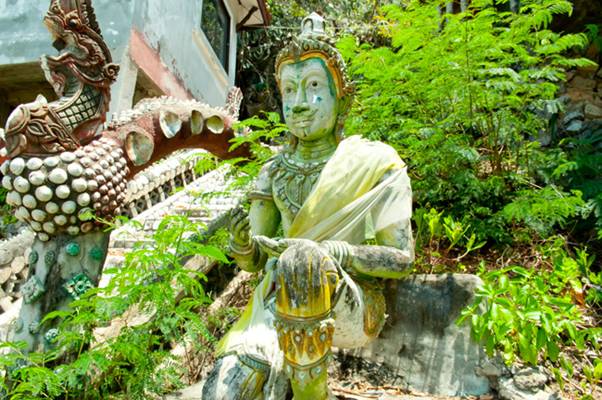
Rustic figurines, and statues, set amongst the overgrown flora at Ao Noi Temple
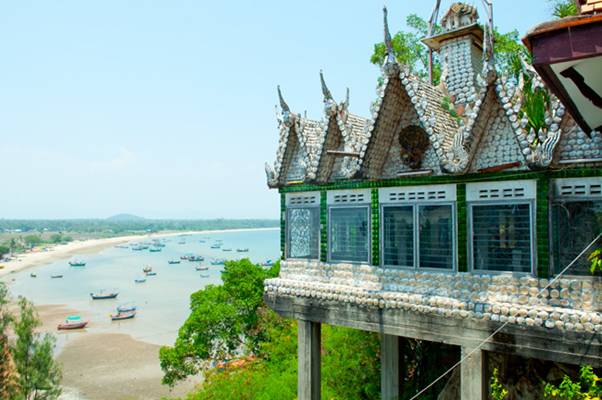
The view from the sea shell covered temple looking North out over Ao Noi Bay
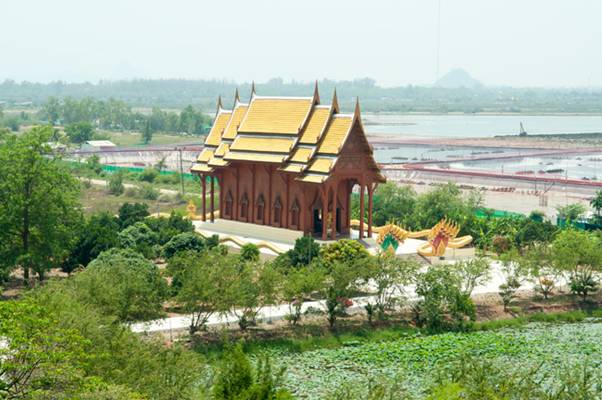
The beautiful all Teak Buddhist Temple with Prachuap town in the distance
We arrived at the rear, of the larger building to find a locked, concertina iron grill door; the type you see on 1940’s style elevators. The view through the gaps revealing the sad state of demise inside; there were loose tiles lying around all over the floor.
“This place has been like this for years. Hardly any tourists come up here and so there’s no money coming in to allow for maintenance,” said Jim, as we continued on to a rocky area at the back of the building.
Scattered amongst the tree roots, and overgrown vegetation, were a number of Buddha statues and small grottos. The one cave, big enough to walk around in, had an amazing line-up of seated Buddha’s along one wall. As we entered I could see, once again, that it was another site in need of some upkeep. After getting a few more shots we made our way back down to the landing in preparation for the long hike up to the cave system which housed the crystal Buddha. We’d spoken briefly with a monk, when we’d arrived, and he was quick to inform us that it was three hundred steps up to the cave. We had quick swig of water and, without much further ado, began the ascent to the top. The climb up was quite spectacular. With the long flight of stairs hugging the Cliffside, the sheer, jungle covered flanks dropped away to reveal the beach below and an uninterrupted vista far to the north. To make things civilized there was a covered wooden hut, on a landing half way up, to provide a rest stop. It was a welcome respite as we took some shade from the blazing midday sun. After another few gulps of water, and another steady upward trudge, we arrived at the cave entrance.
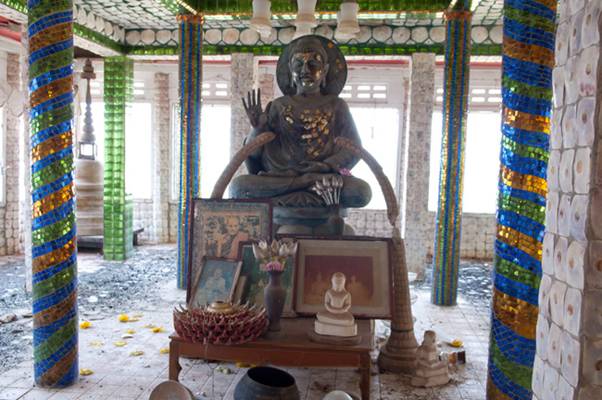
The bizarre, run down interior of one of the small buildings at Ao Noi Temple
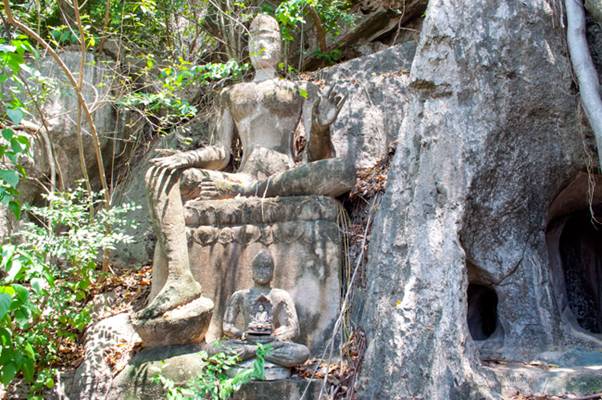
More statues in need of a bit of care
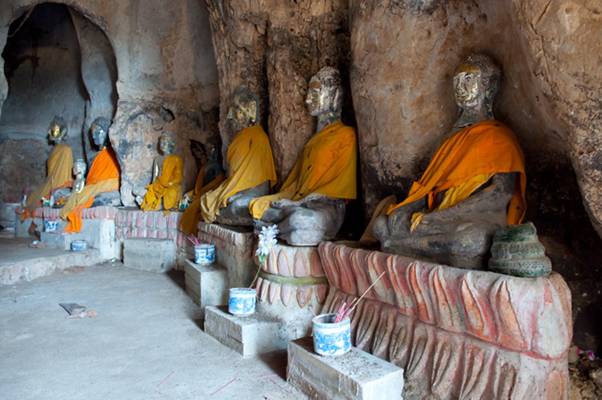
The small cavern, with its impressive line-up of Buddha statues
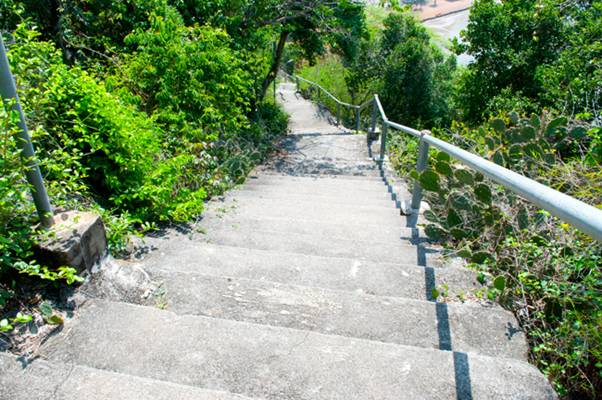
The long climb up is obviated by the view of the beach below
After a few moments spent catching our breath we stepped into the entry chamber to find a long narrow passage with a magnificent reclining Buddha, at least fifteen meters in length, stretched out along the right hand wall.
“The last time I was up here, the lights were on. It looks as though there’s not enough funding coming in to pay for the power,” said Jim, as we flashed our torches over a couple of old flouro’s hanging off some weathered looking electrical wiring.
“It looks as though someone’s been up here recently,” I said, indicating towards the burned incense sticks protruding out of their clay pots near the head of the statue.
“Most likely some locals,” said Jim, as we began to work our way into the black interior of the cave.
After a short walk, along a wide passage way, we arrived at the next chamber. This one was even more impressive than the entry chamber; a wide, raised concrete pad had been built into an alcove that ran off to the left and rear. We stepped onto it and shone our flashlights into dim expanse in front of us. What was revealed was quite remarkable. To the left was another reclining Buddha – approximately ten meters in length – and directly in front of us was an amazing formation of Buddha’s, or replicas of monks, in the lotus position. Jim had already mentioned something about this earlier and, as I looked at the rows of statues, it wasn’t difficult to agree with his assessment that this might possibly be the only place in Thailand where such a grouping exists.
“Each statue has a different face,” said Jim, as we moved in for a closer look.
I shone my torch over each face and saw that he was indeed correct; each face was different. Whether, or not, they were replicas of Monks, previously residing at the temple, one couldn’t be sure but the work that must have gone into creating the individuality of each statue was quite remarkable. Due to there being no light – apart from that of our torches – in the cave, it took me a while get the shots I wanted. Finally, after quite a bit of time playing around with exposure settings, we were on our way to the last stop; the crystal Buddha. It wasn’t much further on – only fifty meters along another passage – and a couple of minutes later we were standing in a large chamber with a small, clear Buddha positioned in the middle. The statue, situated on a small platform, was only three feet in height and, as I moved in for a closer inspection I was convinced that it was made of plastic. A quick rap with my small metal torch, on its surface, convinced me otherwise; it was made entirely of glass. It may not have been sparkling, lead based crystal but the hollow, glowing statue was still an incredible piece of craftsmanship.
“That’s where the beam of light comes through,” said Jim, as he pointed his flashlight towards a hole in the cave ceiling directly above us.
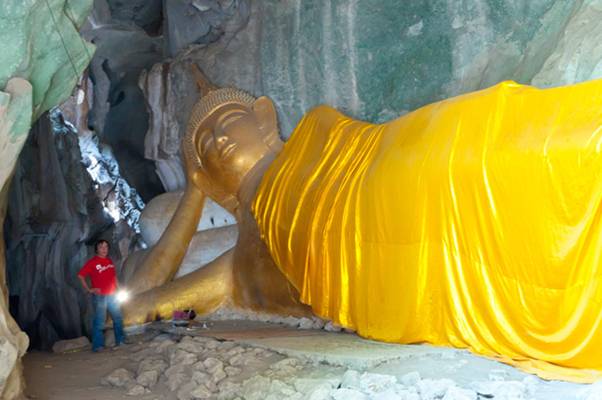
Jim giving a size perspective of the reclining Buddha in the entry chamber
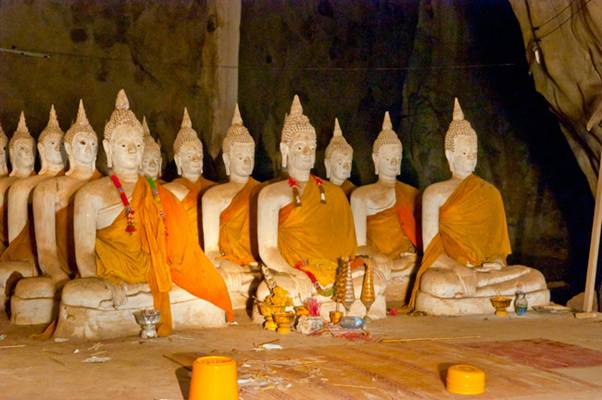
The strange line-up of seated statues; each one with a different face
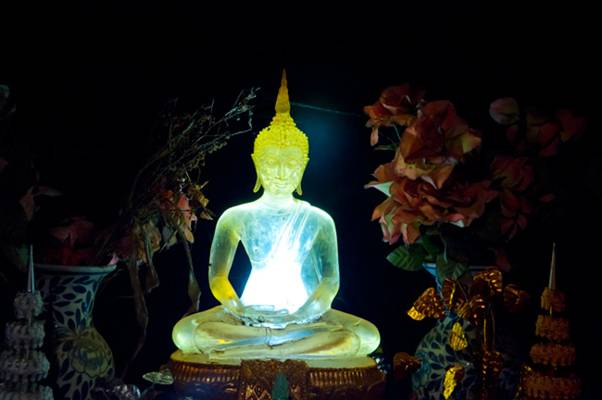
The amazing crystal Buddha statue at the far end of the cave
“Looks as though we’re a bit late,” I said, as I looked up to see a small hole with daylight showing beyond.
“Yeah, unfortunately. It’s supposed to be quite an impressive sight with a shaft of light coming down through that hole and lighting up the statue,” said Jim .
In a makeshift attempt to replicate the beam of light I got Jim to crouch down behind the crystal Buddha and shine the flashlight up into the torso; the resulting shots showed a reasonable attempt at lighting it up. Satisfied with how things had gone we decided to end our tour through the cave and head down. Fifteen minutes later we were back at the car park and keen to get on our way for a snack somewhere. Seeing how it was part of the same complex, the decision was taken to make a quick detour to see the teak temple first as it was only three hundred meters further along the access road running around the cliff line. Jim had been to the site, when it was being built, and had seen some of the massive floor planks that had been used in the construction.
“Some of those floor boards are twenty feet long and a foot thick. And, it’s all solid teak. It’s gotta be worth a fortune,” he said, as we pulled up in front of the ornate multi-headed snakes guarding the entrance.
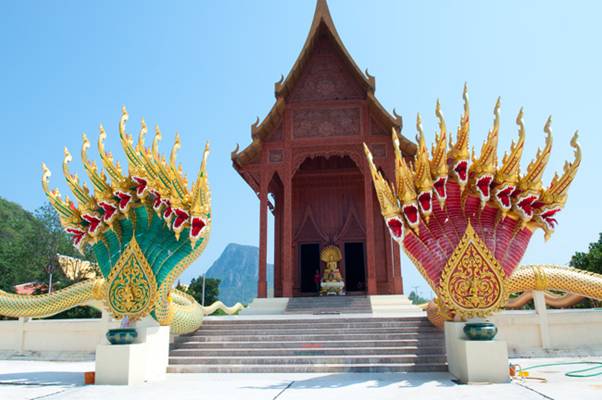
The multi-headed Naga’s at the entry to Wat Ao Noi
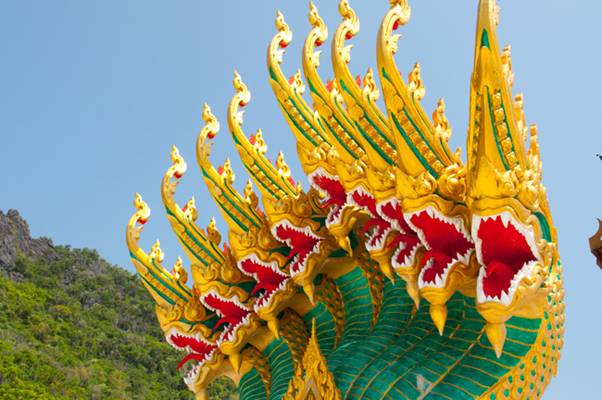
One of the multi headed Naga at the Temple entrance
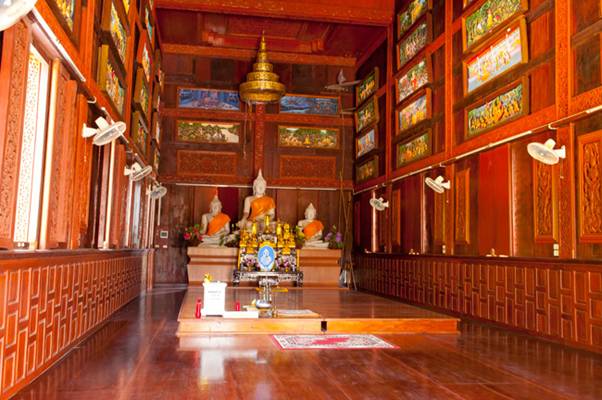
The beautiful teak woodwork of the inner temple
We moved towards the entrance. All seemed quiet and, as we approached the doorways, we could see that there was no one inside. A close up inspection revealed that the entire temple, apart from the roof, was built completely of teak; the ornate woodwork, of the interior, was quite stunning. The floor planks, as Jim had mentioned earlier, were massive and abutted so precisely that there were no gaps visible. I fired off a few more shots and then we hit the road for a snack before heading up to the border.
During the drive down, from Hua Hin, Jim had given me a bit of background info about what to expect at Singkhorn border village. It was situated at the narrowest part of Thailand; a mere twelve kilometers, in a straight line, back to the coast. In fact it was possible to still see the ocean from one the high points up there. There was also a refugee (hill tribe people from Burma) village which sold a range of products derived solely from the jungles of Burma.
“They can only sell stuff they get from the jungle. All the natural timber furniture, the jewelry and the orchids all comes from the jungle on the Burmese side. The village has been there for years and there’s a big natural products market. You’ll see when we get there,” said Jim, as we started to climb away from the coastal plain.
Thirty minutes later we crested a final rise and, as we descended into a picturesque little valley, the border check point came into view. Jim drove the vehicle right up to the guard house and then pulled over to a nearby parking area. There was a large concrete structure straddling the road with a couple of office buildings tucked in underneath. As we approached I got the impression that the general mood of the place was fairly casual; none of the staff looked too interested in what we were doing there.
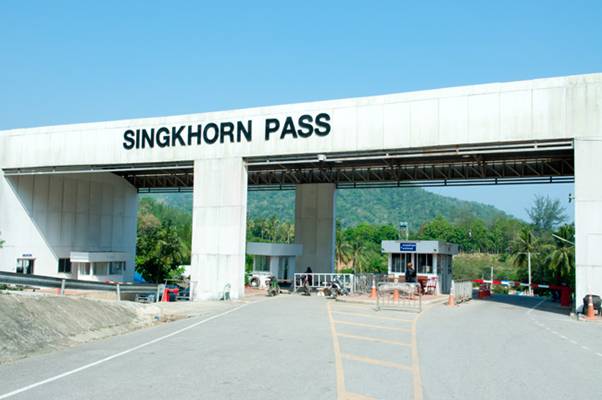
On the Burma side looking back towards Thailand
“The fact is that foreigners can’t pass into Burma through this border crossing, it’s for Thais and Burmese only,” said Jim, as we approached the small office in the middle of the road.
A female immigration officer opened the door and, after a friendly chat, we were given permission to walk a few meters up the road on the Burmese side to get some photos. Jim continued a hundred meters, or so, further up the road to have a look at a construction site. A couple of minutes later I joined him; we were looking through a mesh fence down what appeared to be an expansive village under construction.
“This is being built because the border here will be open to foreigners in the not too distant future. All those people in the refugee village will move back over here and the market, back on the Thai side, will become much smaller. You can already see it happening now. The last time I was up here, about twelve months ago, the market was a lot bigger. Parts of it have closed down already.”
“When are they going to open up the border for entry to foreigners,” I said, getting interested in the idea that a trip into Burma would be on the cards quite soon.
“I can’t say for sure but I’ve heard that it could be as soon as next month,” said Jim, as we started making our way back to the border check point.
“Well, if they eventually set up an immigration office here it will certainly make border runs a simple exercise,” I said, as we wandered on down the hill and into the natural products market.
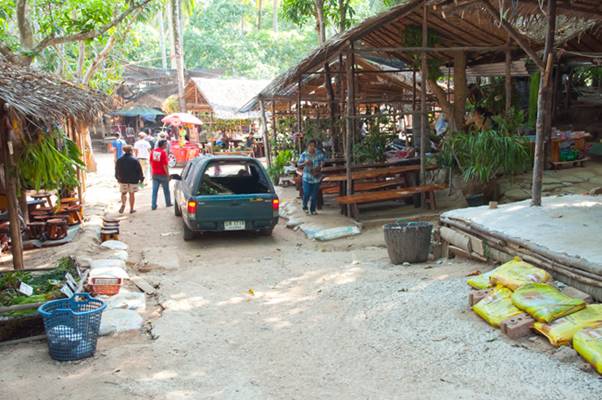
The hill tribes natural produce market just inside the Thai border
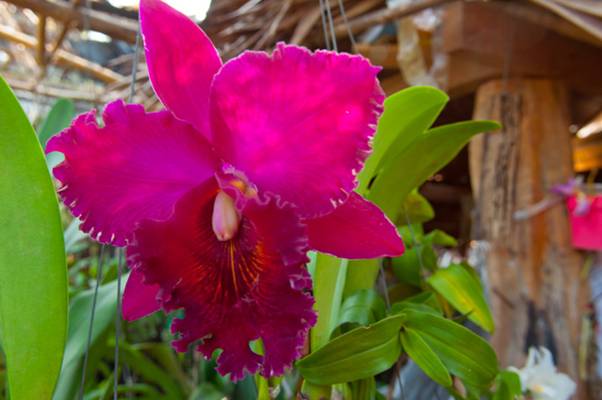
Orchards from the jungles of Burma
The refugee village was a myriad of interesting little lanes, and pathways, crowded with thatched roofed, open buildings displaying an amazing assortment of predominantly solid timber furniture, plants and colourful orchids. Some of the table tops were simply massive slabs of hardwood that had been milled, sanded and lacquered. An enquiry at one of the stalls regarding the weight of a slab table, and bench seat set, got a reply that it was in the vicinity of 600 kilos. Looking at thickness of the wood I had no doubts; the table top was a good five inches thick. We continued on until we entered a market garden area, profuse with a stunning, colourful array of orchids.
“All of these come from high up in the jungle canopy. They climb up and get them out of the boughs of the trees. There, you can tell by the large root bulb at the base. That’s the part that was feeding off the water in the boughs. Overseas, these things would sell for a fortune. Here, they’re dirt cheap,” said Jim, as we had a closer look at one brilliant purple orchid.
We continued on down the laneways and noted a large part of the market, towards the rear, was vacated.
“That’s where the jewelry market was. I wonder where they’ve moved it to?” said Jim.
A quick talk, with one of the stall holders, and we had our answer; it was now housed in a newly constructed, covered area back towards the checkpoint. The stall holder pointed to a track, leading up the hill, and a couple of minutes later we were entering a large concrete and steel construct.
“Most of what’s in here is of the semi-precious stone variety,” said Jim, as I started having a closer look at the merchandise spread out on the tables.
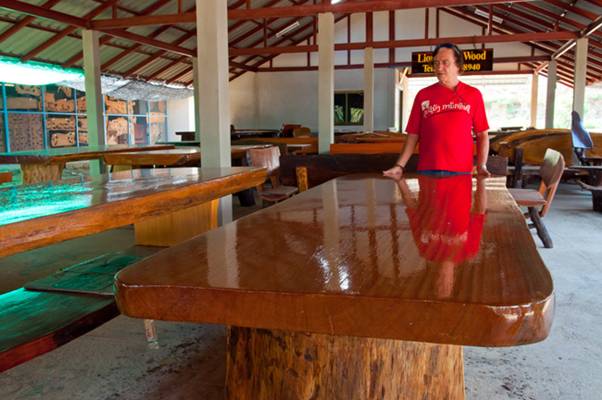
Jim with a massive hardwood table; five meters in length and made from one piece
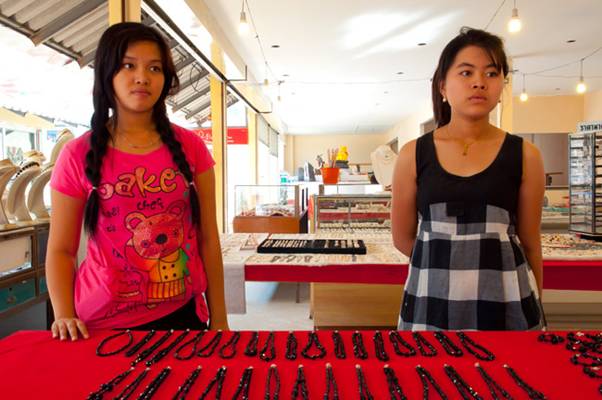
A couple of Burmese charmers at the natural jewelry shop
As I wandered amongst the tables, and cabinets, it was incredible to think that everything on display had come out of the jungles of Burma. Spread out before us were rubies, turquoise, onyx, jade, cultured pearls, peridot, red coral, and a bunch of other stuff in loose, and jewelry, form and the amazing thing was that it was all quite inexpensive. No doubt, as the border opens up, and the location becomes better known, that will change. After browsing, and procrastinating for a good thirty minutes, or more, I finally gave in to temptation and bought a nice little jade Buddha. With the shopping completed and time ticking away Jim was keen to get up to the bunker complex overlooking the border crossing.
We drove back up the hill and turned left into a parking area on a site at the very top of the hill. As we moved towards a circle of camouflaged buildings set below ground level, and in a circular formation, Jim started giving a bit of background history on the complex.
“A few years ago there’s no way we’d be allowed in here. The place was on full alert, for any aggression from the Burmese, and fully manned, “said Jim, as we worked our way around the perimeter.
“Looks as though things are fairly sedate now,” I said, as we passed a couple soldiers digging up a tree root.
“Yeah, it’s because of the normalizing of relations with Burma. It wasn’t that long ago that they were lobbing shells at each other,” said Jim, as we stood next to a sandbagged bunker, minus the machine gun, that looked directly out over the border crossing.
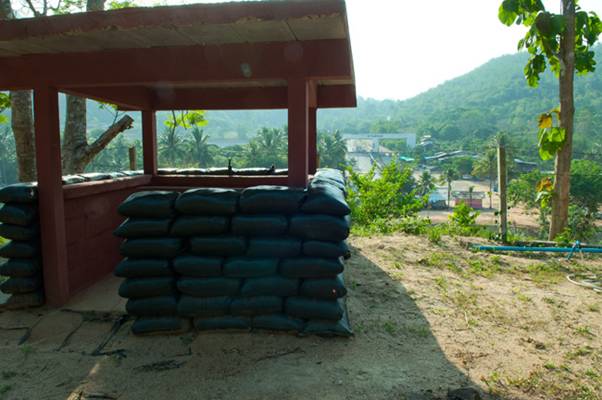
A bunker – minus the machine gun – overlooking the border pass
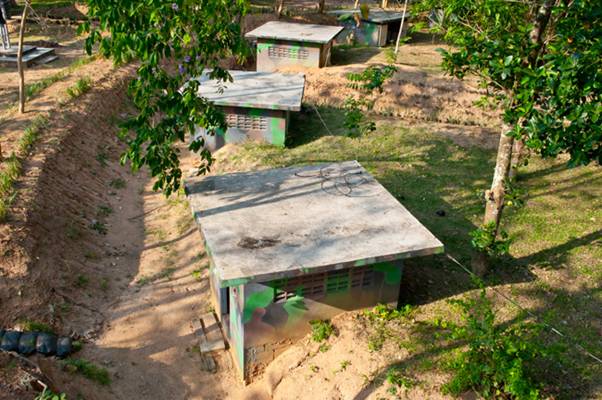
More of the Thai border bunker complex
“Thank Buddha for that,” I said, as we made our way up a lookout tower.
From the tower we got a good overview of the entire complex. It was basically an outer circle, of below ground bunkers, connected to a central command bunker – also below ground – by two dissecting trenches running between the twelve o’clock and six o’clock position, on the outer circle, and the nine o’clock and three o’clock position.
“What are our chances of sneaking a look at the command bunker,” I said, as we made our way back down the tower.
“No harm in trying,” said Jim, as we moved towards the access to the below ground bunker complex.
I think we got no more than five meters away when we were warned off by a polite, but firm, shake of the head by the soldiers digging up the tree route. With an accompanying smile, it was indicated that we should continue on around the other side of the perimeter and back to the car park.
“No problems, it’s getting late and we need to be on our way. We’ve still got one last location to visit,” said Jim, as made our way back to the car.
“Where to next?”
“The stones.”
“The stones, what the hell is that?”
“You’ll see soon enough,” said Jim, as we barreled up the hill and away from Singkhorn.
A few minutes later we arrived at a T-Junction and, instead of turning back towards the coast, turned left heading further inland.
“The last time I came out here I couldn’t find the place. I drove around for an hour, or so, and ended up on a dead end track. This time we’ll stop one of the locals and find out exactly where it is. Someone will know because there’s a temple on the site,” said Jim, as we continued down a remote looking back country road.
“What, exactly, is there to see?” I said, my curiosity rising.
“You see that big boulders out in the field over there?” said Jim, pointing to a pile of what looked like huge marbles.
“Yep.”
“That, only bigger and lots more all piled up, on a hill,” said Jim, as he slowed and started flagging down a local on a motorbike.
Luckily we’d had the foresight to bring Jim’s daughter with us for the day. She was fluent in Thai, and English, and we were soon on our way again with the directions to the “stones.” Another couple of kilometers down the road and we found the turn off we were looking for. After crossing a creek, and a short run up a dirt track, we were pulling into a parking area adjacent to a pile of massive round boulders.
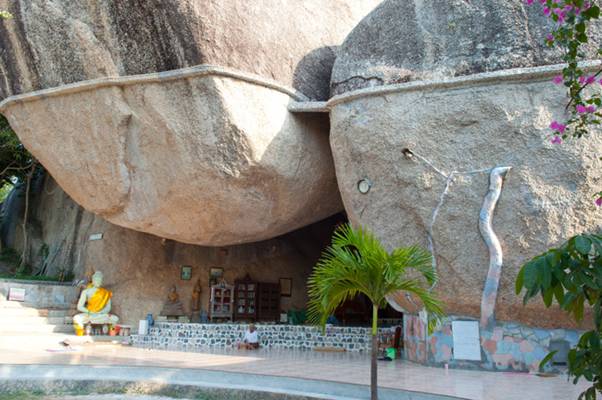
Hin Thern Temple
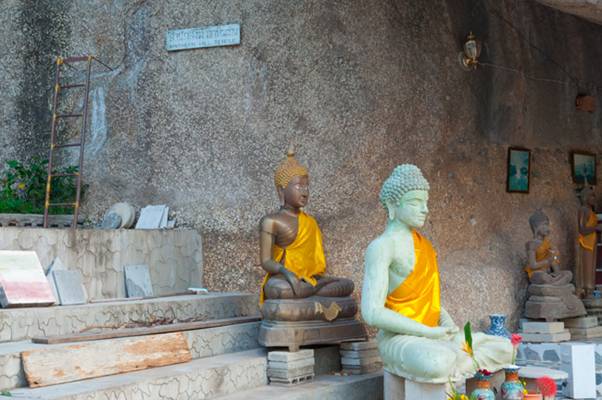
Plenty of Buddha statues dotting the landscape
“Welcome to the stones,” said Jim, as we climbed a flight of tiled steps up onto a wide, tree shrouded garden area.
A few meters beyond, I could see what looked like a very unusual set up for a temple. A tiled forecourt led up to an inner sanctum formed by three massive boulders; the biggest of which was sitting on top of, and spanning, a large space between the two supporting. There were a number of Buddha statues situated off to one side and as I moved in to bang off a couple of shots the resident Nuns took a break, from their yard clearing activities, to have a chat with us. The whole site was quite surreal and almost had a “Lord of the Rings” feel to it.
“You see that strip running around the rocks,” said Jim, pointing up to an addition that was obviously man made.
“Yep.”
“That’s a guttering. It keeps their living area dry and diverts the rainwater to collection tanks below.”
“Impressive. Where does that trail lead to?” I said, indicating towards a stairway running off to the left of the temple area.
“That does a circle around the whole hill and finishes over there on the right hand side of the temple.”
“Do we have time for a quick stroll?”
“Yeah but be warned, getting lost is a distinct possibility,” said Jim, sounding wary.
“You’re kidding, right?”
“No, the last time I came up here, a few years back, I took a wrong turn somewhere and spent hours running around, in amongst the rocks, before finding my way back out. I was with the wife and it was that late in the day that we were seriously considering camping out for the night. We were already beginning to collect firewood when, luckily, we stumbled on a trail and managed to find our way back down here just as it was getting dark,” said Jim, as he had a bit of chuckle about it.
“Okay, we’d better make sure we remember the landmarks on the way then,” I said, leading off up the stairway.
As we worked our way under, and around, the jumbled mass of huge boulders it wasn’t hard to understand how getting lost could be a real possibility. Luckily the trail was well worn and there were directional arrows, at every turn, pointing the way. As we wandered on through this miniature hobbits world I half expected Gandalf to appear in front of us. Eventually we came to a plateau, with a huge counter- balanced rock, which appeared to be a dead end. There was a vertical drop into thick scrub, all around, and no obvious continuing trail visible. To make matters more confusing there was an arrow pointing off to the left which, if one followed it, took you straight to the edge of the plateau and a vertical drop beyond.
“See what I mean?” said Jim, having another laugh.
“No problems, we’ll just retrace our steps back to that last junction we saw.”
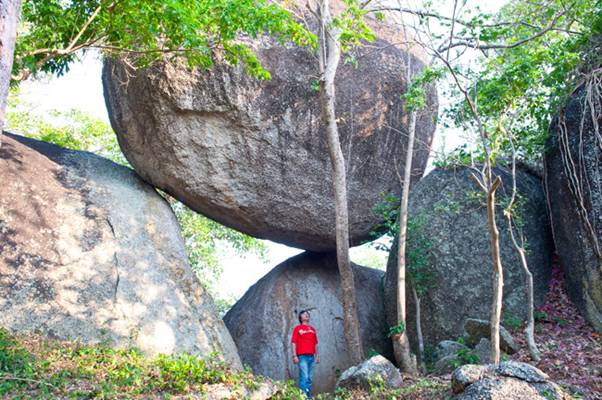
Massive boulders balanced in an uncanny manner
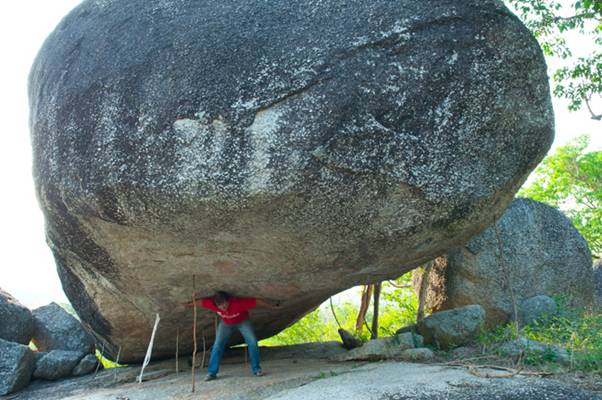
Jim playing silly buggers with a massive boulder which is counter balanced
After a few more minutes spent taking in the spectacular views across the peaks towards Burma we ambled back along the trail until we came to a fork. There was no indicating arrow but the general direction was back towards the temple. After a bit more time scrambling up and down a goat track we rounded a large rock to see the backside of the temple in front of us.
“Looks like won’t have to camp out after all,” I said, with a wry grin to Jim.
“Thankfully, I’ve just run out of cigarettes.”
With the sun setting over the horizon we bade farewell to the “stones.” It had been a brilliant day, off the beaten track, in Prachuap Khiri Khan Province.
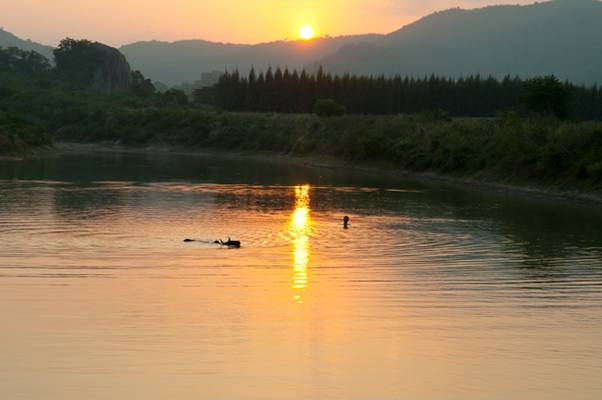
A beautiful scene to end a great day out in Prachuap Khiri Khan Province
For anyone interested in getting off the beaten track in Prachuap Khiri Khan you can contact Jim:
Jim_coconuts@hotmail.com
+66 (0) 811914627
TBC…

Stickman's thoughts:
Very, very nice trip report.
* As a small suggestion, be a little less aggressive with the saturation slider when processing your photos.
